2004 IOTA Meeting and Asteroid Occultations in
the California Desert
June 29 - July 5
The 2004 International Occultation Timing Association meeting was held in Apple
Valley, CA in the Mojave Desert to coincide with 4 asteroid occultations crossing
central/southern California in one week. I needed another vacation and after
loading up on library books-on-tape (some Zane Gray, books on classical composers
and their music, Stephen King...) and packing the 10" LX200 and video gear,
I headed out on Tuesday June 29.
Helga Occultation: First stop was the occultation
of a 10.9 star by Helga. The wide path had a small error range and seemed
like a slam dunk for my set up. I selected a position south of the centerline,
near Hwy 58 where it touched the Los Padres National Forest northwest of Carrizo
Plain National Monument.
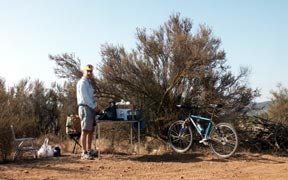 But
as I pulled into my camp spot, a dim bank of cirrus clouds grew and was clearly
moving north at a rate and with an extent that threatened to cover the entire
path. I got the scope and gear set up and waited, but the star was never visible
through the clouds, losing over 2 magnitudes through the muck. The nearby full
moon sure didn't help. Box score... Clouds 1, Rick 0. My report is here.
But
as I pulled into my camp spot, a dim bank of cirrus clouds grew and was clearly
moving north at a rate and with an extent that threatened to cover the entire
path. I got the scope and gear set up and waited, but the star was never visible
through the clouds, losing over 2 magnitudes through the muck. The nearby full
moon sure didn't help. Box score... Clouds 1, Rick 0. My report is here.
OK, the disappointment didn't stop me from enjoying a good breakfast of fried
veges and potatoes, and then a bike ride along the local trails. Then, back
on the road. I wanted to check out Mt. Pinos - the favorite observing site of
the Los Angeles Astronomical Society - for future reference, and because I was
considering this site for the Angelina occultation in 3 days. It also was a
good excuse to route me through some pretty country at higher, cooler elevations.
After driving through Carrizo Plain, I headed up the mountain and 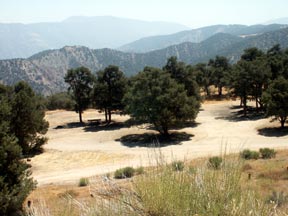 checked
out Valle
Vista campground, a site Jay and I almost drove to in April to get the comet
views smogged out at Carrizo. McGill Campground group site #A looked like a
good site with a
checked
out Valle
Vista campground, a site Jay and I almost drove to in April to get the comet
views smogged out at Carrizo. McGill Campground group site #A looked like a
good site with a 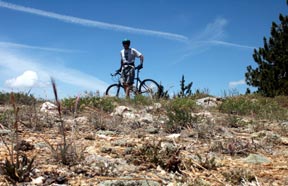 panoramic
view to the east. I then drove to the big parking lot at the 8300' level and
mountain biked the trails up to the summit for a little lunch and exercise,
and to trip down memory lane. I have fond memories of UCLA Sierra Club excursions
XC skiing Mt. Pinos in my grad school days in the early 80's. At right, I'm
at the summit, looking south.
panoramic
view to the east. I then drove to the big parking lot at the 8300' level and
mountain biked the trails up to the summit for a little lunch and exercise,
and to trip down memory lane. I have fond memories of UCLA Sierra Club excursions
XC skiing Mt. Pinos in my grad school days in the early 80's. At right, I'm
at the summit, looking south.
Nanon Occultation: Next stop was in Apple Valley
at the Lewis Research Center to meet
with pre-IOTA meeting observers of that night's occultation
by the asteroid Nanon. This was the most favorable event of the bunch, and
the brightest event of the year for California so far. The star was 8.6 magnitude
so we were all optimistic. I got the latest update on the ~50 mile wide path
of the occultation; an additional 8 miles further south of the already 1/2 path
width south as of several days before. 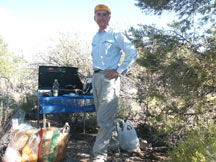 My
planned observing site was at Cactus Flat 6000' feet up in the mountains east
of Big Bear Lake. My site was now only about 0.2 path widths from the northern
limit - making the odds of success lower than I'd like.
My
planned observing site was at Cactus Flat 6000' feet up in the mountains east
of Big Bear Lake. My site was now only about 0.2 path widths from the northern
limit - making the odds of success lower than I'd like. 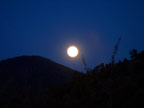 Still,
this was the site I'd promised to occupy and other observers were fencing themselves
to accomodate, so I stuck with the plan. A bumpy 3 mile rock/dirt road drive
brought me to a nice camp site amid pinyon pine, Joshua trees, and granite rock
formations. I cooked dinner, watched the full moon rise, and set up my equipment:
the 10" LX200 with f/6.3 focal reducer, PC164c video camera feed to the
Canon ZR45 miniDV camcorder. I did a 2-star alignment, verified the necessary
pointing accuracy and left the scope running off the 115 amp-hour deep cycle
batter while I got some sleep. At 2am I got up and things were looking good
- the star was bright and the sky was clean with just a few cirrus. But then
a cloud generated by a standing wave formed off of 11,500 ft Mt. San Gorgonio
south of me and grew. The star was at the southern boundary of this cloud and
shown
Still,
this was the site I'd promised to occupy and other observers were fencing themselves
to accomodate, so I stuck with the plan. A bumpy 3 mile rock/dirt road drive
brought me to a nice camp site amid pinyon pine, Joshua trees, and granite rock
formations. I cooked dinner, watched the full moon rise, and set up my equipment:
the 10" LX200 with f/6.3 focal reducer, PC164c video camera feed to the
Canon ZR45 miniDV camcorder. I did a 2-star alignment, verified the necessary
pointing accuracy and left the scope running off the 115 amp-hour deep cycle
batter while I got some sleep. At 2am I got up and things were looking good
- the star was bright and the sky was clean with just a few cirrus. But then
a cloud generated by a standing wave formed off of 11,500 ft Mt. San Gorgonio
south of me and grew. The star was at the southern boundary of this cloud and
shown 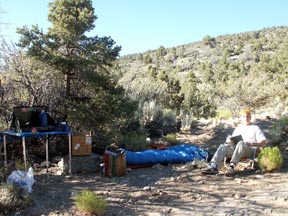 through,
but the cloud thickened and made things iffy.. until the critical moment when
the cloud over the star was thickest and the star was nearly invisible - but
not quite. Now unfortunately, the star was too bright to be included in the
UCAC2 catalog and only had Tycho2 data. This probably led to the south shifts
in the updates, and the final observed path was an additional south shift of
another 1/2 path width, giving me a miss. However a number of our group did
set up south of center, on the boundary of Joshua Tree National Park and did
get the occultation. Box score: 0-2 for our hero :( . My report is here.
In the morning, I had an early breakfast of skillet veges, potatoes and eggs,
read some more of "The Elegant Universe", which I'm thoroughly enjoying,
and packed up and drove to Big Bear Lake to explore the town, get on the web
at the library, and mountain bike around the lake. A nice day, finishing with
a dinner at a little Mexican restaurant before heading back to my previous night
campspot.
through,
but the cloud thickened and made things iffy.. until the critical moment when
the cloud over the star was thickest and the star was nearly invisible - but
not quite. Now unfortunately, the star was too bright to be included in the
UCAC2 catalog and only had Tycho2 data. This probably led to the south shifts
in the updates, and the final observed path was an additional south shift of
another 1/2 path width, giving me a miss. However a number of our group did
set up south of center, on the boundary of Joshua Tree National Park and did
get the occultation. Box score: 0-2 for our hero :( . My report is here.
In the morning, I had an early breakfast of skillet veges, potatoes and eggs,
read some more of "The Elegant Universe", which I'm thoroughly enjoying,
and packed up and drove to Big Bear Lake to explore the town, get on the web
at the library, and mountain bike around the lake. A nice day, finishing with
a dinner at a little Mexican restaurant before heading back to my previous night
campspot.
IOTA Annual Conference:
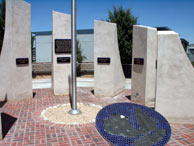 Next
morning was Friday - the official beginning of the
Next
morning was Friday - the official beginning of the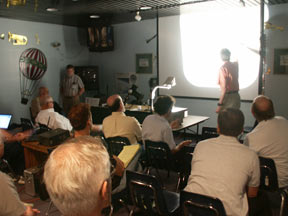 IOTA conference at the Lewis Research
Center..The meeting had 27 asteroid and grazing lunar occultation
observers who presented papers on the latest technology for accurately timing
these events, and reductions of some recent events.
IOTA conference at the Lewis Research
Center..The meeting had 27 asteroid and grazing lunar occultation
observers who presented papers on the latest technology for accurately timing
these events, and reductions of some recent events.
Derald Nye, a long time friend from my postdoc years at Steward Observatory
in Tucson, came with an impressive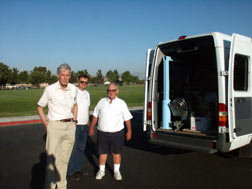 setup - a van specialized for mobile graze and asteroid occulation observations.
Here, David Dunham and John Stockbauer chat with Derald (right).
setup - a van specialized for mobile graze and asteroid occulation observations.
Here, David Dunham and John Stockbauer chat with Derald (right).
Angelina Occultation: The toughest of the 3 asteroid
occultations was at 4:19am Saturday morning. The group made detailed plans to
cover the path of the Angelina
occultation of an 11.9 magnitude star in Aries. This star had UCAC2
coordinates and updates to the path were very stable. 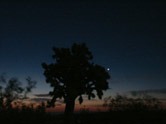 Nevertheless,
Walt Morgan had tried and failed to see the star in his 8" under moonless
conditions, so having a full moon in the sky and high winds in the dusty desert
with the brown gunk of the LA basin coming over the mountains...
Nevertheless,
Walt Morgan had tried and failed to see the star in his 8" under moonless
conditions, so having a full moon in the sky and high winds in the dusty desert
with the brown gunk of the LA basin coming over the mountains... 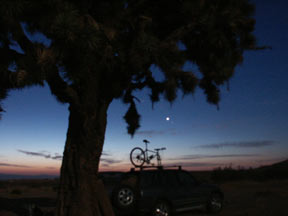 I
was not confident. I volunteered to take track 26s, which passed through the
Kramer Hills about 40 miles northwest of Apple Valley, and a place I'd explored
back in the '70's during my high school astronomy club days. Conditions were
NOT good; even a hint of cirrus cloud would be enough to make it impossible,
and cirrus were all over the sky. Plus, winds were 20-30mph and brought a haze
illuminated by the full moon. I picked my way along a dirt road until at the
junction with Kramer Rd (also dirt) a large Joshua tree promised a way to make
a wind block. At crunch time, the scope was pointing well and even though the
star was too faint to see on the LCD screen, I trusted it was there and started
recording. I had no idea whether it worked. Right after the event, dawn began
and Venus rose in close conjunction with Aldebaren inside the Hyades star cluster,
making a nice site over the Joshua tree shading my setup.
I
was not confident. I volunteered to take track 26s, which passed through the
Kramer Hills about 40 miles northwest of Apple Valley, and a place I'd explored
back in the '70's during my high school astronomy club days. Conditions were
NOT good; even a hint of cirrus cloud would be enough to make it impossible,
and cirrus were all over the sky. Plus, winds were 20-30mph and brought a haze
illuminated by the full moon. I picked my way along a dirt road until at the
junction with Kramer Rd (also dirt) a large Joshua tree promised a way to make
a wind block. At crunch time, the scope was pointing well and even though the
star was too faint to see on the LCD screen, I trusted it was there and started
recording. I had no idea whether it worked. Right after the event, dawn began
and Venus rose in close conjunction with Aldebaren inside the Hyades star cluster,
making a nice site over the Joshua tree shading my setup.
It's now 2019. Dave Gault is reviewing this ancient event and finding some timing discrepancies with the DAMIT model. Alas, my miniDV tape was sent off to Frank Anet at a time when he had health problems and the tape seems to be gone. I never got a reduction or word on what happened to my mailing. However, I do have the notes, and that I believe I did have an occultation after visual inspection of my tape. I guessed a duration of about 1 second, but certainly can't rule out it was actuall 1.5 seconds, which is what the sky plane map with DAMIT model suggest should be true. Here's the new (2019) sky plane as of now...

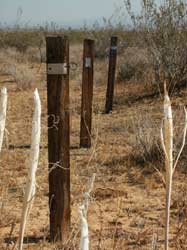 After breakfast, I explored the area a bit.
After breakfast, I explored the area a bit.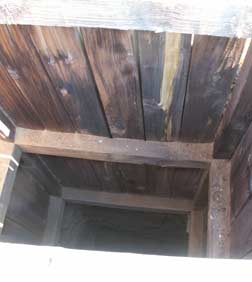 At left are old mining claim stakes, found near an abandoned mine shaft
At left are old mining claim stakes, found near an abandoned mine shaft
Driving back to Apple Valley, I could only hope that the star could be pulled
out of the noise through image processing and stacking of frames. In fact, using
equipment set up at the conference room, I was able to see the star barely at
the limit of detectability on screen, and to see a brief disappearance at the
predicted time. Success! Adjusting the brightness of the LCD camcorder screen
later I was able to see it even better, although still very tough. Looks like
I recorded a ~1.0 second event at my station. Angelina looks to be much smaller
than predicted, suggesting the asteroid is far more reflective than thought.
Our data is showing this asteroid to be far different than expected; more so
than any other event I've observed. I'm sending my tape to Frank Anet who will
produce a light curve and time axis; thanks Frank! My report on this event is
here.
IQ Tours - Quaking Aspen Family Camping Trip: It
was now Saturday mid day, and the IOTA meeting was wrapping up. I left, drove
north and stopped at Randsburg ghost
town for a burger and chocolate malt at the famous 120 year old general
store there, drove over Walker Pass to Lake Isabella where I jumped in and swam
(took a bath, really) for a half hour.
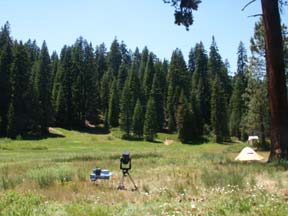 Then,
on to Quaking Aspen campground where my friend Dave Wyman was conducting a camping
trip
Then,
on to Quaking Aspen campground where my friend Dave Wyman was conducting a camping
trip 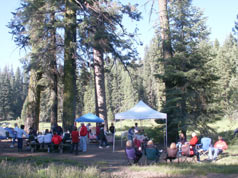 for
families and I planned to show them the stars.
for
families and I planned to show them the stars.
Quaking Aspen campground is in a beautiful meadow a few miles north of the
site of our Astro 28J trip. It's
got great horizons for doing astronomy. Sunday morning at 4am the "randsburger"
I had the previous afternoon had me violently ill, and I spent most of the day
groaning in my tent when not in the john. But by mid afternoon I felt better.
Enough to roll over and snap this picture of the moon setting over the pines.
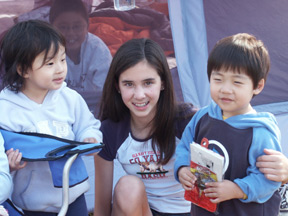 I
helped Dave put together a slide show of digital shots of the group before an
evening LCD slide show at the camp amphitheater, and by evening
I
helped Dave put together a slide show of digital shots of the group before an
evening LCD slide show at the camp amphitheater, and by evening 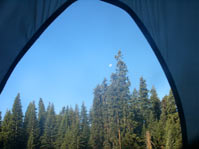 was
ready for a marathon session of showing the summer Milky Way wonders under dark,
perfect skies.
was
ready for a marathon session of showing the summer Milky Way wonders under dark,
perfect skies.
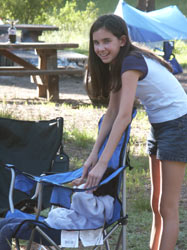
It was a good trip, and I'm glad I got at least one of the 3 occultations and
some science in the bag. 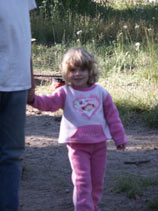
back to home.
 But
as I pulled into my camp spot, a dim bank of cirrus clouds grew and was clearly
moving north at a rate and with an extent that threatened to cover the entire
path. I got the scope and gear set up and waited, but the star was never visible
through the clouds, losing over 2 magnitudes through the muck. The nearby full
moon sure didn't help. Box score... Clouds 1, Rick 0. My report is here.
But
as I pulled into my camp spot, a dim bank of cirrus clouds grew and was clearly
moving north at a rate and with an extent that threatened to cover the entire
path. I got the scope and gear set up and waited, but the star was never visible
through the clouds, losing over 2 magnitudes through the muck. The nearby full
moon sure didn't help. Box score... Clouds 1, Rick 0. My report is here. checked
out
checked
out  panoramic
view to the east. I then drove to the big parking lot at the 8300' level and
mountain biked the trails up to the summit for a little lunch and exercise,
and to trip down memory lane. I have fond memories of UCLA Sierra Club excursions
XC skiing Mt. Pinos in my grad school days in the early 80's. At right, I'm
at the summit, looking south.
panoramic
view to the east. I then drove to the big parking lot at the 8300' level and
mountain biked the trails up to the summit for a little lunch and exercise,
and to trip down memory lane. I have fond memories of UCLA Sierra Club excursions
XC skiing Mt. Pinos in my grad school days in the early 80's. At right, I'm
at the summit, looking south.
 Still,
this was the site I'd promised to occupy and other observers were fencing themselves
to accomodate, so I stuck with the plan. A bumpy 3 mile rock/dirt road drive
brought me to a nice camp site amid pinyon pine, Joshua trees, and granite rock
formations. I cooked dinner, watched the full moon rise, and set up my equipment:
the 10" LX200 with f/6.3 focal reducer, PC164c video camera feed to the
Canon ZR45 miniDV camcorder. I did a 2-star alignment, verified the necessary
pointing accuracy and left the scope running off the 115 amp-hour deep cycle
batter while I got some sleep. At 2am I got up and things were looking good
- the star was bright and the sky was clean with just a few cirrus. But then
a cloud generated by a standing wave formed off of 11,500 ft Mt. San Gorgonio
south of me and grew. The star was at the southern boundary of this cloud and
shown
Still,
this was the site I'd promised to occupy and other observers were fencing themselves
to accomodate, so I stuck with the plan. A bumpy 3 mile rock/dirt road drive
brought me to a nice camp site amid pinyon pine, Joshua trees, and granite rock
formations. I cooked dinner, watched the full moon rise, and set up my equipment:
the 10" LX200 with f/6.3 focal reducer, PC164c video camera feed to the
Canon ZR45 miniDV camcorder. I did a 2-star alignment, verified the necessary
pointing accuracy and left the scope running off the 115 amp-hour deep cycle
batter while I got some sleep. At 2am I got up and things were looking good
- the star was bright and the sky was clean with just a few cirrus. But then
a cloud generated by a standing wave formed off of 11,500 ft Mt. San Gorgonio
south of me and grew. The star was at the southern boundary of this cloud and
shown  through,
but the cloud thickened and made things iffy.. until the critical moment when
the cloud over the star was thickest and the star was nearly invisible - but
not quite. Now unfortunately, the star was too bright to be included in the
UCAC2 catalog and only had Tycho2 data. This probably led to the south shifts
in the updates, and the final observed path was an additional south shift of
another 1/2 path width, giving me a miss. However a number of our group did
set up south of center, on the boundary of Joshua Tree National Park and did
get the occultation. Box score: 0-2 for our hero :( . My report is
through,
but the cloud thickened and made things iffy.. until the critical moment when
the cloud over the star was thickest and the star was nearly invisible - but
not quite. Now unfortunately, the star was too bright to be included in the
UCAC2 catalog and only had Tycho2 data. This probably led to the south shifts
in the updates, and the final observed path was an additional south shift of
another 1/2 path width, giving me a miss. However a number of our group did
set up south of center, on the boundary of Joshua Tree National Park and did
get the occultation. Box score: 0-2 for our hero :( . My report is  Next
morning was Friday - the official beginning of the
Next
morning was Friday - the official beginning of the IOTA conference at the
IOTA conference at the  setup - a van specialized for mobile graze and asteroid occulation observations.
Here, David Dunham and John Stockbauer chat with Derald (right).
setup - a van specialized for mobile graze and asteroid occulation observations.
Here, David Dunham and John Stockbauer chat with Derald (right). Nevertheless,
Walt Morgan had tried and failed to see the star in his 8" under moonless
conditions, so having a full moon in the sky and high winds in the dusty desert
with the brown gunk of the LA basin coming over the mountains...
Nevertheless,
Walt Morgan had tried and failed to see the star in his 8" under moonless
conditions, so having a full moon in the sky and high winds in the dusty desert
with the brown gunk of the LA basin coming over the mountains...  I
was not confident. I volunteered to take track 26s, which passed through the
Kramer Hills about 40 miles northwest of Apple Valley, and a place I'd explored
back in the '70's during my high school astronomy club days. Conditions were
NOT good; even a hint of cirrus cloud would be enough to make it impossible,
and cirrus were all over the sky. Plus, winds were 20-30mph and brought a haze
illuminated by the full moon. I picked my way along a dirt road until at the
junction with Kramer Rd (also dirt) a large Joshua tree promised a way to make
a wind block. At crunch time, the scope was pointing well and even though the
star was too faint to see on the LCD screen, I trusted it was there and started
recording. I had no idea whether it worked. Right after the event, dawn began
and Venus rose in close conjunction with Aldebaren inside the Hyades star cluster,
making a nice site over the Joshua tree shading my setup.
I
was not confident. I volunteered to take track 26s, which passed through the
Kramer Hills about 40 miles northwest of Apple Valley, and a place I'd explored
back in the '70's during my high school astronomy club days. Conditions were
NOT good; even a hint of cirrus cloud would be enough to make it impossible,
and cirrus were all over the sky. Plus, winds were 20-30mph and brought a haze
illuminated by the full moon. I picked my way along a dirt road until at the
junction with Kramer Rd (also dirt) a large Joshua tree promised a way to make
a wind block. At crunch time, the scope was pointing well and even though the
star was too faint to see on the LCD screen, I trusted it was there and started
recording. I had no idea whether it worked. Right after the event, dawn began
and Venus rose in close conjunction with Aldebaren inside the Hyades star cluster,
making a nice site over the Joshua tree shading my setup.
 After breakfast, I explored the area a bit.
After breakfast, I explored the area a bit. At left are old mining claim stakes, found near an abandoned mine shaft
At left are old mining claim stakes, found near an abandoned mine shaft Then,
on to Quaking Aspen campground where my friend Dave Wyman was conducting a camping
trip
Then,
on to Quaking Aspen campground where my friend Dave Wyman was conducting a camping
trip  for
families and I planned to show them the stars.
for
families and I planned to show them the stars.  I
helped Dave put together a slide show of digital shots of the group before an
evening LCD slide show at the camp amphitheater, and by evening
I
helped Dave put together a slide show of digital shots of the group before an
evening LCD slide show at the camp amphitheater, and by evening  was
ready for a marathon session of showing the summer Milky Way wonders under dark,
perfect skies.
was
ready for a marathon session of showing the summer Milky Way wonders under dark,
perfect skies.
